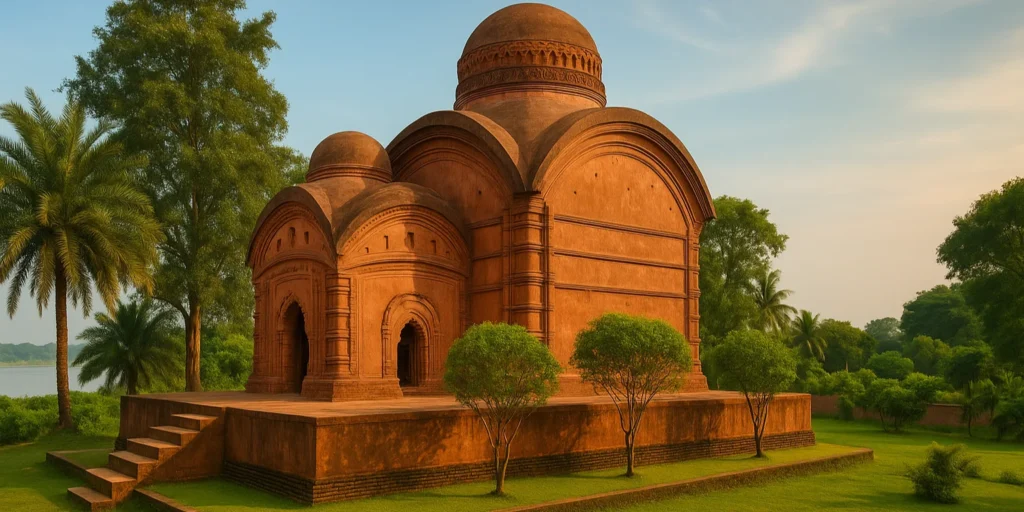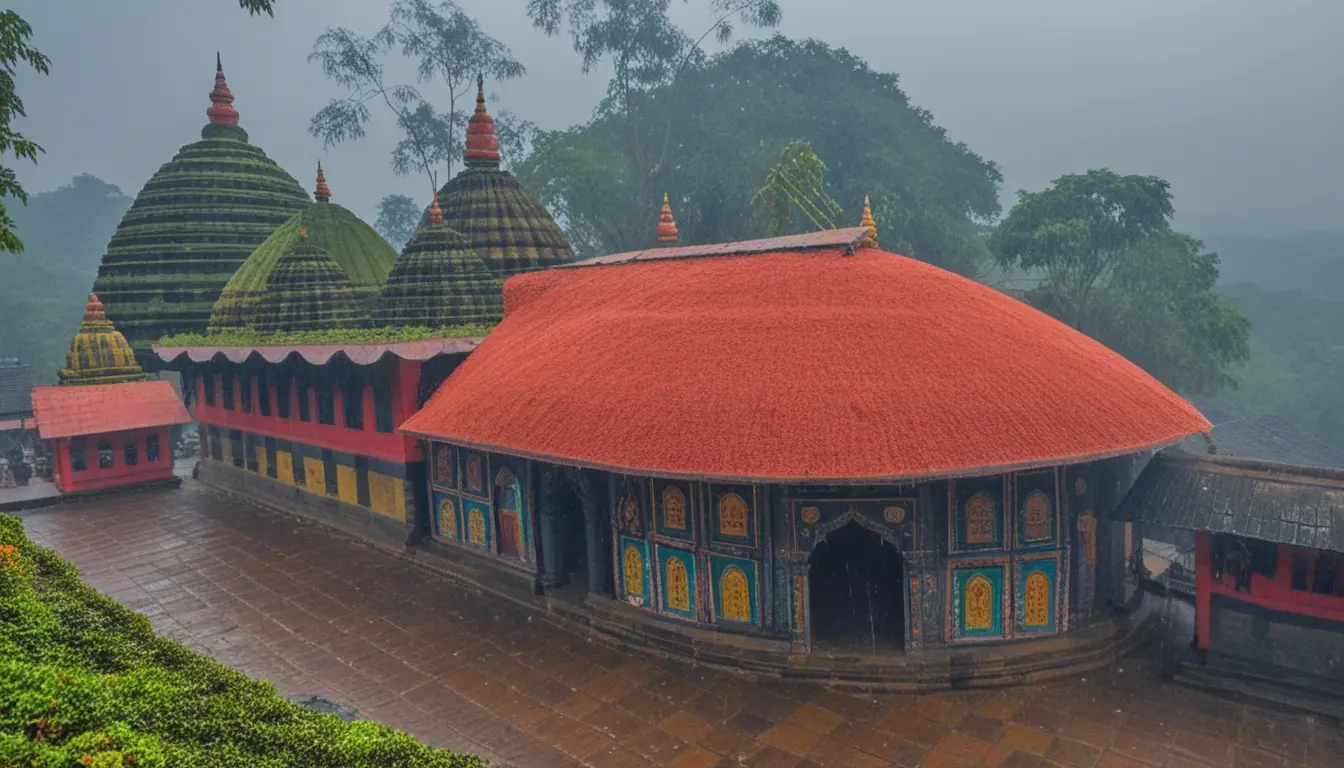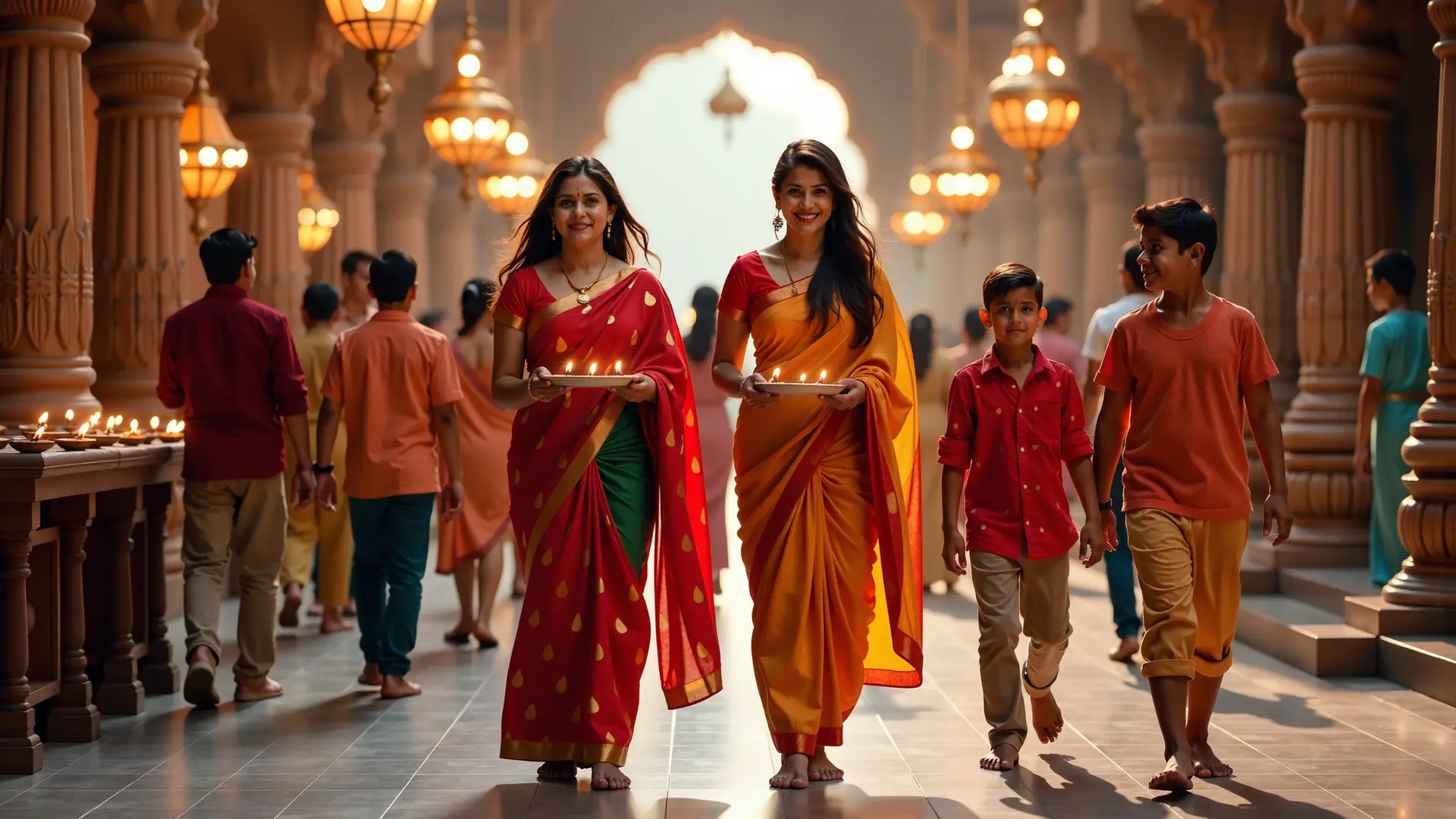
Priest’s Note: This teaching belongs to our Kamakhya GuidePedia. Seek more wisdom in the sacred navigation [🕉️ Kamakhya Temple GuidePedia Navigation 🕉️] below ↓↓↓↓.
Bhubaneswari Temple in Guwahati is one of Assam’s most peaceful hilltop sanctuaries—perfect for anyone seeking silence, spiritual clarity, and breathtaking views. Located atop the Nilachal Hills, this lesser-known temple sits above the famous Kamakhya Shrine and offers a stunning blend of nature, tradition, and divine tranquility.
Imagine a serene white temple surrounded by lush green hills, with the Brahmaputra River shimmering under a golden sky—that’s the magic waiting for you here.

🌺 What Sets Bhubaneswari Temple in Guwahati Apart as a Sacred Haven
Dedicated to Goddess Bhubaneswari, one of the ten Mahavidyas and a revered form of the divine cosmic mother, this temple radiates a gentle, uplifting energy the moment you step near its hilltop gates. Unlike the constantly buzzing Kamakhya complex below, the atmosphere here feels almost suspended in time—quiet, airy, and filled with an unmistakable sense of grace.
Pilgrims often say that the climb to the temple feels like leaving the world behind. As you ascend a little higher above Kamakhya, the sounds of the city fade, replaced by the whisper of cool Nilachal winds and the distant call of hillside birds. The space opens up into a wide panoramic stretch where the Brahmaputra glows like flowing gold during sunrise and Guwahati spreads out peacefully beneath your feet.
It’s this rare combination—divinity, serenity, and unspoiled views—that makes Bhubaneswari Temple in Guwahati not just another religious site but a place where many visitors naturally pause, breathe deeper, and feel quietly connected to something larger.
🕰️ History of Bhubaneswari Temple
While the exact date of its origin remains unknown, architectural style and historical conjecture place the temple’s construction broadly in the 17th or 18th century.
The pristine white dome, delicate lotus motifs, and carved panels create a striking contrast to the surrounding hills and river valley. It is built of stone, cement, and marble, featuring intricate carvings and sculptures that reflect a blend of Assamese and Mughal styles.
History Wrapped in Mystery: What We Know — and What We Can Only Wonder About
The exact date of construction of the Bhubaneswari Temple in Guwahati remains unknown. There are no inscriptions or records that clearly establish when the first structure was built. Yet, local traditions, the long lineage of Shakti worship on Nilachal Hills, and the temple’s vantage point above Kamakhya all point to a fascinating possibility.
Nilachal has been a center of Tantra and Shakti worship for thousands of years, with many sacred spots evolving over time into formal temples. Given this deep spiritual legacy, it’s entirely reasonable to assume that the holy site of Bhubaneswari Temple may have existed long before the current architecture took shape.
Based on its style, historians suggest that the existing structure—with its distinct Nilachal-style dome and traditional motifs—was likely constructed or reconstructed in the 17th or 18th century. But the origin of the shrine itself?
That might stretch far deeper into the past.
What do you think?
Could this serene hilltop temple be sitting on a much older sacred footprint, quietly carrying the memory of rituals performed long, long ago?
🌄 Location & Distance from Kamakhya Temple
- Location: The Bhubaneswari Temple stands on top of Nilachal Hills, Guwahati.
- Distance from Kamakhya temple to Bhubaneswari Temple: Approx. 1–1.5 km
- Altitude: Around 165 feet higher than the Kamakhya shrine
Most visitors describe the walk as peaceful, scenic, and deeply meditative—with chirping birds, cool winds, and sweeping views along the route.
🚶♂️ Getting There: A Pilgrim’s Path
The scenic 30-minute walk uphill from Kamakhya Temple to Bhubaneswari Temple is meditative in itself. Along the way, nature wraps you in birdsong and cool breezes as you ascend towards peace.
For travel guidance, check our detailed post:
👉 How to Reach Kamakhya Temple: Complete Travel Guide
🌅 Best Views in Guwahati
If you love scenic beauty, this temple is a must-visit. From the hilltop, you can see:
- The sprawling Brahmaputra River
- Entire Guwahati city
- Hills of Meghalaya on clear days
- Magical sunrise and sunset views
📸 Photography Highlights
Most-searched queries on Google include “Bhubaneswari Temple photos,” and rightly so—the visuals here are unforgettable:
- Golden hour over the Brahmaputra
- Misty morning views
- Architectural close-ups of the dome and carvings
- Wide-angle cityscapes
This serene site is a photographer’s paradise—where whitewashed domes meet pastel skies and sweeping river views. Whether it’s the golden hour over the Brahmaputra or intricate carvings lit by soft morning light, every shot here tells a story. Perfect for mobile photography, DSLRs, and drone shots (where permitted).
You can further explore these panoramic treasures of Kamakhya Hills in our guide:
👉 Sacred Heights, Stunning Sights: Kamakhya Hill’s Panoramic Secrets
🧘♀️ Spiritual Significance and Festivities
The temple becomes especially vibrant during festivals like Ambubachi Mela, when devotees climb up seeking blessings and peace. Even on regular days, the atmosphere feels serene and spiritually grounding.
Curious about the festivals and legends that enrich this region? Dive into these articles:
- Unveil the Magic of Kamakhya Temple Festivals
- Ambubachi Mela at Kamakhya Temple: The Most Powerful Festival in Assam
External Source: Trawell on Bhubaneswari Mandir
🕒 Visitor Information
Bhubaneswari Temple Timings:
The Bhubaneswari Temple in Guwahati is generally open from 6:00 AM to 8:00 PM, with a short break in the afternoon. Visitors can usually come at any time during these hours, but timings may vary on special days.
Important Note:
There may be temporary closures for maintenance, rituals, or festival preparations. It’s always wise to check the latest schedule locally before planning your visit.
Best Time to Visit:
- Daylight hours for panoramic views of Guwahati and the Brahmaputra
- Sunrise or sunset for the most breathtaking, golden-hued vistas
- Festival seasons—especially Navratri and Ambubachi Mela—for a spiritually charged atmosphere
Entry Fee:
Free for all visitors.
Dress Code:
Modest, respectful clothing is appreciated. Traditional wear is common, but any comfortable attire that covers shoulders and knees is suitable.
👉 Know How To Dress To Visit Kamakhya Temple
🌟 Nearby Attractions
Exploring Bhubaneswari Temple opens up several nearby gems:
- 🛕 Kamakhya Temple: Dive into the spiritual core of Shakti worship.
- 🏝️ Umananda Island: The Most Unique River Island
- 🏛️ Assam State Museum: Explore cultural and historical artifacts from across Assam.
🙌 Final Thoughts
If you want silence, scenic bliss, and spiritual depth, Bhubaneswari Temple in Guwahati is the ultimate hilltop retreat. It’s peaceful yet powerful, remote yet accessible, and perfect for travelers, pilgrims, photographers, and anyone who simply needs a breath of calm.
And if you’re planning a full journey around Kamakhya Hill, don’t miss this guide:
👉 Ultimate Guide to the 5 Best Attractions Around Kamakhya Temple!
FAQs About Bhubaneswari Temple in Guwahati
What is the Bhubaneswari Temple in Guwahati famous for?
Bhubaneswari Temple is known for its peaceful hilltop location above Kamakhya Temple, offering breathtaking panoramic views of the Brahmaputra River, Guwahati city, and the surrounding hills. It is also revered for its spiritual calm and connection to Goddess Bhubaneswari.
What are the timings of Bhubaneswari Temple in Guwahati?
The temple is generally open from 6:00 AM to 8:00 PM, with a short afternoon break. Visitors should check locally for exact timings, as schedules may change due to rituals, maintenance, or events.
What is the best time to visit Bhubaneswari Temple?
The best time to visit is during daylight hours to enjoy scenic views. Sunrise and sunset are especially beautiful. For spiritual seekers, visiting during Navratri or the Ambubachi Mela offers a vibrant festival experience.
Is there an entry fee for Bhubaneswari Temple in Guwahati?
No. Entry to the Bhubaneswari Temple is completely free for all visitors.
How far is Bhubaneswari Temple from Kamakhya Temple?
The temple is located about 1–1.5 km uphill from Kamakhya Temple and sits approximately 165 feet higher on the Nilachal Hills. Many visitors prefer the scenic 20–30 minute walk between the two temples.
What is the history of Bhubaneswari Temple?
The exact construction date is unknown. However, the Nilachal architecture style suggests the current structure may have been built or reconstructed around the 17th–18th century. The sacred site itself may be much older, as Nilachal Hills have been a center of Shakti worship for thousands of years.
How do I reach Bhubaneswari Temple in Guwahati?
Visitors can walk uphill from Kamakhya Temple, take a local auto, or hire a cab. The final approach typically involves a short climb, but the path is scenic and pleasant.
Is photography allowed at Bhubaneswari Temple?
Yes, photography is allowed, and the hilltop is a popular spot for capturing sunrises, sunsets, and sweeping views of Guwahati and the Brahmaputra River.
Is Bhubaneswari Temple safe for solo travelers?
Yes, the temple area is generally safe for solo travelers during regular visiting hours. Early mornings and late evenings see fewer people, so daylight hours are recommended for solo visits.
Are there any festivals celebrated at Bhubaneswari Temple?
Major festivals include Navratri and Ambubachi Mela, during which devotees visit the temple for blessings, rituals, and special prayers.
🕉️ Kamakhya Temple GuidePedia Navigation 🕉️
Your complete guide to the sacred temple
🛕 Temple Guide 🛕
🏛️ Attractions 🏛️
🏨 Accommodation 🏨
🍽️ Food & Dining 🍽️
✨ Spiritual Secrets ✨
🚗 Guwahati → 5 Gems 🚗
🙏 Explore the divine journey through Kamakhya Temple 🙏


